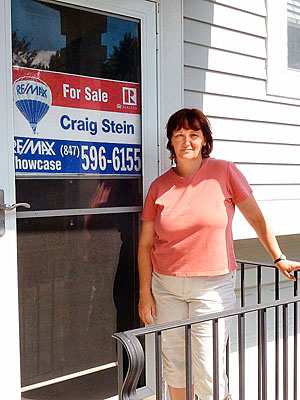
The next mortgage payment on Christine O’Malley’s Grayslake townhouse is due Monday, but she’s probably not going to pay it.
“I’ve been on my own since I was 18, and I’ve always paid my bills,” says O’Malley, 53. She is employed as a co-owner of an e-learning company, says she has credit scores in “the high 700s, 800s,” and has been trying to sell the three-bedroom townhouse for more than a year.
Finally, feeling that she was out of options, she has decided to quit making payments while the home is on the market as a short sale, in the hope that it sells before the lender forecloses. “It’s a process of elimination,” she told me Monday in the kitchen of the townhouse, which she bought for $192,000 in December 2004. “I’ve been around and around, and you ultimately get to this point where you didn’t want to be.”
The story of how O’Malley arrived at her decision shows how the ongoing housing price crash and strict lending practices can push a homeowner toward walking away from a mortgage contract.
Seven years ago, O’Malley bought the house on a balloon loan, which carried a low interest rate but dictated that in December 2011, O’Malley would have to refinance the terms of the loan or make a hefty final payment. By early 2010, her Lake County property taxes had risen so much that she moved to McHenry County, buying a townhouse in Johnsburg and putting the Grayslake townhouse on the market for $185,000.
“I remember thinking that’s a big loss, since when I bought [in Grayslake] I thought I’d leave at about $225,000,” O’Malley says. She soon dropped the price to $175,000—91 percent of what she had paid for the home five and a half years before.
No offers materialized. O’Malley made a deal with a woman who wanted to rent the home until she cleaned up her credit and could buy it. The monthly rent covered the mortgage but not the $149 monthly homeowners’ association fees. “I thought if she didn’t buy it, I could keep her as a renter until the market cleared up,” O’Malley says, but the arrangement soured quickly, and the renter moved out with time left on the one-year lease.
O’Malley put the home back on the market at $165,000. She knew she couldn’t cover payments on two homes, so she consulted her lender about refinancing in the spring—interest rates were still super-low. In June, she learned that two things disqualified her from the least-expensive mortgages: one, she’s self-employed, and two, the lender now saw the home as an investment property. “I told them I had never intended to be a landlord, to have investment property, [but that] I was just doing what I had to when the house wouldn’t sell,” she says, but the lender’s rules were strict. “Even my high credit scores didn’t matter to them,” she says.
This month, O’Malley came to understand she could no longer do “the right thing, paying my loan.” In order to cover the August 1 payments on both homes, she’d need $1,000 more than her monthly income.
“Can’t do it. Can’t do it,” she told me. The home is listed at $145,000, the amount she owes on the mortgage, and O’Malley says she hopes but doubts that an acceptable offer will come through at that amount so the bank gets everything it is owed.
While disappointed to have reached the point of nonpayment on a mortgage, O’Malley says she felt she had no other options left. If the bank ultimately forecloses, she says, at least “the next day, I’ll still be breathing.”


